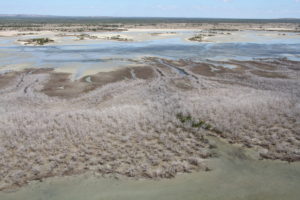8 May 2019
A revised look at tidal wetlands in remote northern Australia has uncovered a surprising new understanding of their responses to changing climate.
Mangrove and saltmarsh–saltpan communities appear to act as one combined ecological niche. As rainfall conditions vary, one seems to expand while the other contracts, with no net change in total area, provided all other things remain the same. So for example during decades of relatively high rainfall, mangroves expand while saltmarsh-saltpans contract, and vice versa. Despite all the pressures on tidal wetlands, it seems that moisture and salinity are often the dominant and predictable determinants of relative cover for these globally recognised habitats of tropic and subtropic regions. For more information see this new scientific paper, the project webpage or contact project leader Dr Norm Duke.

Want to know more about the Resilient Landscapes Hub's activities and our research into practical solutions to environmental problems? Stay informed about activities, research, publications, events and more through the Hub newsletter.